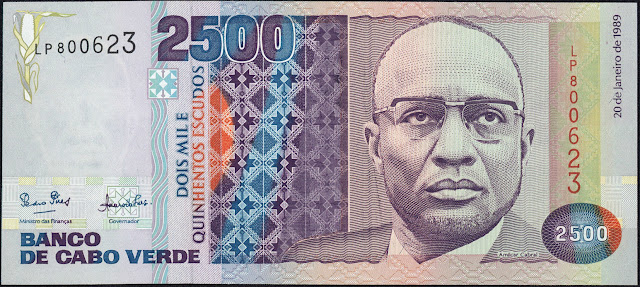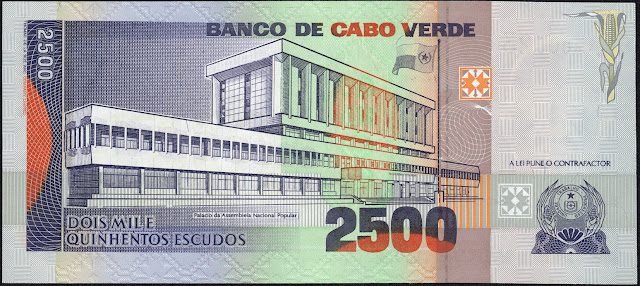Currency of Cape Verde 2500 Escudos banknote 1989 Amilcar Cabral
Bank of Cape Verde - Banco de Cabo Verde
Dominating the front’s composition and occupying approximately two thirds of the note and leaning to the right, there’s the effigy of Amilcar Cabral, the founder of Cape Verdean nationality. This effigy is flanked to the left and right by a drawing of "Pano d’obra Bicho Antigo," made in Tarrafal, Santiago Island. In the upper right corner, reading upwards, there’s the text "20 de Janeiro de 1989."
In the left third part, there’s the watermark with the effigy of Amilcar Cabral. In the upper left corner, there’s the stylization of an ear of corn, one of the elements of the Cape Verde escudo, which coincides with the same element – by transparency – on the back of the note. In the lower left corner and immediately after the ear of corn, there’s the series number, consisting of figures which are differentiated and aligned horizontally. The same series number is also on the right side of the note, reading downwards.
The back of the note carries an illustration of the Palacio da Assembleia Nacional Popular, the Palace of the People’s National Assembly, the symbol of national sovereignty. The Assembly today consists of seventy-two deputies elected by universal adult suffrage. There are several interesting points to note about the illustration on this note, as they identify features that changed in the ensuing years. Firstly, the caption on the note identifies the building as the Palacio da Assembleia Nacional Popular and with the ascendancy of the MPD as the ruling party, the name of the Assembly was changed to the Assembleia Nacional. Secondly, the flag on the flag pole was changed in 1992, to remove the symbols associated with the PAIGC. Thirdly, and not directly related to the illustration, is the national emblem of Cape Verde, which is to the right of the illustration. This emblem was replaced in 1992 and a new emblem adopted.
In the same third, beyond the watermark with the effigy of Amilcar Cabral and above the silver band, there’s the text “A Lei Pune o Contrafactor”.
Watermark: Amilcar Cabral.
Dimensions: 150 x 67 mm.
Predominant Color: Lilac.
Cape Verde Banknotes - Cape Verde Paper Money
20.01.1989 "Amilcar Cabral" Issue
It is not known when the second series of notes was introduced, but it was almost certainly during 1989. The date on the notes is once again the anniversary of the death of Amilcar Cabral and National Heroes Day— 20 January 1989. There are five denominations in this series—100, 200, 500, 1000 and 2500 escudos—and while each note in the series shares a common design, there are distinct elements for each denomination.
The front of each note is dominated by a portrait of the mature Amilcar Cabral, but each note is of differing sizes, colours and incorporates different patterns. Common to each note are the watermark of Amilcar Cabral (a copy of the illustration on the front of the notes), the clear micro-printed security thread (with the micro-printing reading ‘BCV’ for Banco de Cabo Verde), the national emblem (on the back of the notes), a perfect registration device of a cob of corn, micro-printing of ‘BANCODECABOVERDE’, and fluorescent features. The fluorescent features on the front of the notes are the right-hand serial number, which fluoresces in gold, the left-hand serial number, which fluoresces in green, and the security thread that fluoresces in blue-green.
To the immediate left of the portrait of Amilcar Cabral on each note is a pattern based on old Pano d’obra (traditional strip-woven cloths) made in Tarrafal, on the island of Santiago. Each denomination has a different pattern based on a cloth constructed by classically designed narrow-strip-weave textiles. A square of the distinctive pattern is also used as a perfect registration device for each denomination, appearing beneath the signature of the governor of the bank. The cloth pattern on each note also contains a latent image, consisting of ‘BCV’ and the denomination of the note.
On the back of the notes, viewed in portrait format, is a five-pointed star wrapped in a semi-circular scroll holding Banco de Cabo Verde and the denomination written above and below the insignia. Various inks on the back of each note also fluoresce. The notes are signed by General Pedro Verona Rodrigues Pires, the Minister of Finance, and Amaro Alexandre da Luz, the Governor.
The notes of this series were printed by Thomas De La Rue and Company.
Amílcar Lopes da Costa Cabral (12 September 1924 – 20 January 1973) was a Bissau-Guinean and Cape Verdean agricultural engineer, intellectual, poet, theoretician, revolutionary, political organizer, nationalist and diplomat. He was one of Africa's foremost anti-colonial leaders.
Also known by the nom de guerre Abel Djassi, Cabral led the nationalist movement of Guinea-Bissau and Cape Verde Islands and the ensuing war of independence in Guinea-Bissau. He was assassinated on 20 January 1973, about eight months before Guinea-Bissau's unilateral declaration of independence. Although not a Marxist, he was deeply influenced by Marxism, and became an inspiration to revolutionary socialists and national independence movements worldwide.
Amílcar Cabral Early years
Cabral was born 12 September 1924 in Bafatá, Guinea-Bissau, to Cape Verdean parents, Juvenal Antònio Lopes da Costa Cabral and Iva Pinhel Évora, both from Santiago, Cape Verde. His father came from a wealthy land-owning family. His mother was a shop owner and hotel worker in order to support her family, especially after she separated from Amílcar's father by 1929. Her family was not well off, so she was unable to pursue higher education.
Amílcar Cabral was educated at Liceu (Secondary School) Gil Eanes in the town of Mindelo, Cape Verde, and later at the Instituto Superior de Agronomia, in Lisbon (the capital of Portugal, which was then the colonial power ruling over Guinea-Bissau and Cape Verde). While an agronomy student in Lisbon, he founded student movements dedicated to opposing the ruling dictatorship of Portugal and promoting the cause of independence for the Portuguese colonies in Africa.
He returned to Africa in the 1950s, and was instrumental in promoting the independence causes of the then Portuguese colonies. He was the founder (in 1956) of the PAIGC or Partido Africano da Independência da Guiné e Cabo Verde (Portuguese for African Party for the Independence of Guinea and Cape Verde) and one of the founders of Movimento Popular Libertação de Angola (MPLA) (later in the same year), together with Agostinho Neto, whom he met in Portugal, and other Angolan nationalists.
War for independence
From 1963 to his assassination in 1973, Cabral led the PAIGC's guerrilla movement (in Portuguese Guinea) against the Portuguese government, which evolved into one of the most successful wars of independence in modern African history. The goal of the conflict was to attain independence for both Portuguese Guinea and Cape Verde. Over the course of the conflict, as the movement captured territory from the Portuguese, Cabral became the de facto leader of a large portion of what became Guinea-Bissau.
In preparation for the independence war, Cabral set up training camps in Ghana with the permission of Kwame Nkrumah. Cabral trained his lieutenants through various techniques, including mock conversations to provide them with effective communication skills that would aid their efforts to mobilize Guinean tribal chiefs to support the PAIGC. Cabral realized the war effort could be sustained only if his troops could be fed and taught to live off the land alongside the larger populace. Being an agronomist, he taught his troops to teach local crop growers better farming techniques, so that they could increase productivity and be able to feed their own family and tribe, as well as the soldiers enlisted in the PAIGC's military wing. When not fighting, PAIGC soldiers would till and plow the fields alongside the local population.
Cabral and the PAIGC also set up a trade-and-barter bazaar system that moved around the country and made staple goods available to the countryside at prices lower than that of colonial store owners. During the war, Cabral also set up a roving hospital and triage station to give medical care to wounded PAIGC soldiers and quality-of-life care to the larger populace, relying on medical supplies garnered from the USSR and Sweden. The bazaars and triage stations were at first stationary, until they came under frequent attack from Portuguese regime forces.
Death
In 1972, Cabral began to form a People's Assembly in preparation for the independence of Guinea-Bissau, but disgruntled former PAIGC rival Inocêncio Kani, together with another member of PAIGC, shot and killed him on 20 January 1973 in Conakry, Guinea. The possible plan was to arrest Cabral (possibly to judge him summarily, later), but facing the peaceful resistance of Cabral, they immediately killed him.
According to some theories, Portuguese PIDE agents, whose alleged plan eventually went awry, wanted to influence Cabral`s rivals through agents operating within the PAIGC, in hope of arresting Cabral and placing him under the custody of Portuguese authorities. Another theory claims that Ahmed Sékou Touré, jealous of Cabral's greater international prestige, among other motives, orchestrated the conspiracy; both theories remain unproven and controversial.
After the assassination, About one hundred officers and guerrilla soldiers of the PAIGC, accused of involvement in the conspiracy that resulted in the murder of Amílcar Cabral and the attempt to seize power in the movement, were summarily executed. His half-brother, Luís Cabral, became the leader of the Guinea-Bissau branch of the party and would eventually become President of Guinea-Bissau.
A declassified United States Department of State brief notes that the motives of his assassination are unclear but may have linked to "a feud between mulattos from the [sic] Cape Verde islands and mainland Africans." Cabral was assassinated prior to the independence of the Portuguese colonies in Africa, and therefore died before he could see his homelands of Cabo Verde and Guinea Bissau gain independence from Portugal.
Tributes
...one of the most lucid and brilliant leaders in Africa, Comrade Amílcar Cabral, who instilled in us tremendous confidence in the future and the success of his struggle for liberation.
— Fidel Castro, 1966 Tricontinental Conference in Havana, Cuba
Cabral is considered a "revolutionary theoretician as significant as Frantz Fanon and Che Guevara", one "whose influence reverberated far beyond the African continent." Amílcar Cabral International Airport, Cape Verde's principal international airport at Sal, is named in his honor. There is also a football competition, the Amílcar Cabral Cup, in zone 2, named as a tribute to him. In addition, the only privately owned university in Guinea-Bissau — Amílcar Cabral University, in Bissau - is named after him. Jorge Peixinho composed an elegy to Cabral in 1973.
Author António Tomás wrote a biography of Amílcar Cabral, entitled O Fazedor de Utopias: Uma Biografia de Amílcar Cabral, which offers an extensive overview of Amílcar’s life in narrative form and features a detailed account of Amílcar’s family history in Portuguese.
President William R. Tolbert (Republic of Liberia) commissioned and built a housing estate on the Old Road, Sinkor, Monrovia, Liberia, named in honor of Cabral.
Films
- Cabral's political thought and role in the liberation of Guinea-Bissau and Cape Verde is discussed at some length in Chris Marker's film, Sans Soleil (1983). He is also the subject of the Portuguese documentary Amílcar Cabral, released in 2000.
- The documentary film Cabralista, winner of the CVIFF Cape Verde International Film Festival prize for best documentary in 2011, puts Amilcar Cabral's political views and ideologies in the spotlight.

